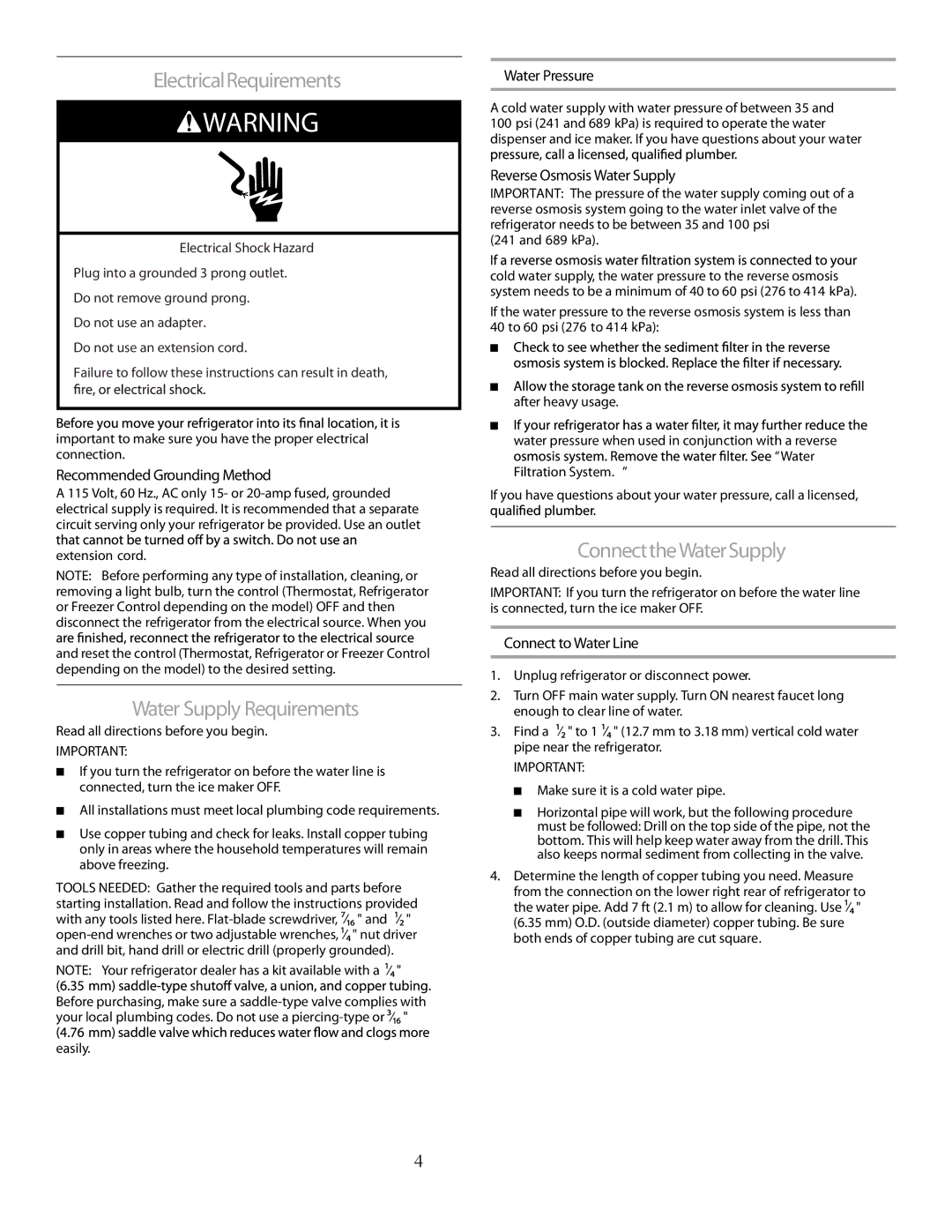
ElectricalRequirements
![]() WARNING
WARNING
Electrical Shock Hazard
Plug into a grounded 3 prong outlet. Do not remove ground prong.
Do not use an adapter.
Do not use an extension cord.
Failure to follow these instructions can result in death,
important to make sure you have the proper electrical connection.
Recommended Grounding Method
A 115 Volt, 60 Hz., AC only 15- or
extension cord.
NOTE: Before performing any type of installation, cleaning, or removing a light bulb, turn the control (Thermostat, Refrigerator or Freezer Control depending on the model) OFF and then disconnect the refrigerator from the electrical source. When you
and reset the control (Thermostat, Refrigerator or Freezer Control depending on the model) to the desired setting.
Water Supply Requirements
Read all directions before you begin.
IMPORTANT:
If you turn the refrigerator on before the water line is connected, turn the ice maker OFF.
All installations must meet local plumbing code requirements.
Use copper tubing and check for leaks. Install copper tubing only in areas where the household temperatures will remain above freezing.
TOOLS NEEDED: Gather the required tools and parts before starting installation. Read and follow the instructions provided with any tools listed here. ![]()
![]()
![]() " and
" and ![]()
![]() "
" ![]()
![]() " nut driver and drill bit, hand drill or electric drill (properly grounded).
" nut driver and drill bit, hand drill or electric drill (properly grounded).
NOTE: Your refrigerator dealer has a kit available with a ![]()
![]() "
"
Before purchasing, make sure a ![]()
![]()
![]() "
"
easily.
Water Pressure
A cold water supply with water pressure of between 35 and
100psi (241 and 689 kPa) is required to operate the water dispenser and ice maker. If you have questions about your water
Reverse Osmosis Water Supply
IMPORTANT: The pressure of the water supply coming out of a reverse osmosis system going to the water inlet valve of the refrigerator needs to be between 35 and 100 psi
(241 and 689 kPa).
cold water supply, the water pressure to the reverse osmosis system needs to be a minimum of 40 to 60 psi (276 to 414 kPa).
If the water pressure to the reverse osmosis system is less than
40 to 60 psi (276 to 414 kPa):
after heavy usage.
water pressure when used in conjunction with a reverse
![]()
![]()
![]()
![]()
![]()
![]()
![]()
![]()
![]()
![]()
![]()
![]()
![]()
![]()
![]()
![]()
![]()
![]()
![]()
![]()
![]()
![]()
![]()
![]()
![]()
![]()
![]()
![]()
![]()
![]()
![]()
![]()
![]()
![]()
![]()
![]() “Water Filtration System. ”
“Water Filtration System. ”
If you have questions about your water pressure, call a licensed,
ConnecttheWaterSupply
Read all directions before you begin.
IMPORTANT: If you turn the refrigerator on before the water line is connected, turn the ice maker OFF.
Connect to Water Line
1.Unplug refrigerator or disconnect power.
2.Turn OFF main water supply. Turn ON nearest faucet long enough to clear line of water.
3.Find a ![]()
![]() " to 1
" to 1 ![]()
![]() " (12.7 mm to 3.18 mm) vertical cold water pipe near the refrigerator.
" (12.7 mm to 3.18 mm) vertical cold water pipe near the refrigerator.
IMPORTANT:
Make sure it is a cold water pipe.
Horizontal pipe will work, but the following procedure must be followed: Drill on the top side of the pipe, not the bottom. This will help keep water away from the drill. This also keeps normal sediment from collecting in the valve.
4.Determine the length of copper tubing you need. Measure from the connection on the lower right rear of refrigerator to the water pipe. Add 7 ft (2.1 m) to allow for cleaning. Use ![]()
![]() " (6.35 mm) O.D. (outside diameter) copper tubing. Be sure both ends of copper tubing are cut square.
" (6.35 mm) O.D. (outside diameter) copper tubing. Be sure both ends of copper tubing are cut square.
4
